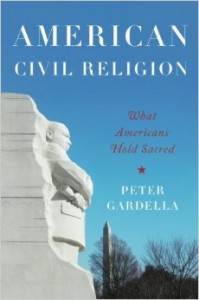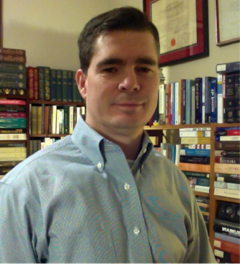Peter Gardella. American Civil Religion: What Americans Hold Sacred. Oxford: OxfordUniversity Press, 2014. 368 pages.
Review by John D. Wilsey
In the first paragraph of his book entitled American Civil Religion: What Americans Hold Sacred, author Peter Gardella notes that “the US government . . . has always found people who hold American symbols and values to be sacred—worth living and dying and perhaps killing for” (1). This visceral and primal commitment that Americans have to their symbols and values points to something greater than mere patriotism, Gardella asserts. This is a commitment that amounts to a real religion. In an April 2014 interview conducted for Marginalia Review of Books by Art Remillard, Gardella said, “You can’t have people putting their lives on the line unless there is a religious dimension to what they’re doing.”[i]
American Civil Religion represents Gardella’s endeavor to provide a coherent explanation of this religion, which consists of four overarching values celebrated in texts, literary forms, monuments, physical spaces, and even ideas. These four values are individual freedom, democracy, world peace, and cultural tolerance. Throughout the book, Gardella argues that American civil religion (ACR) has endured since the establishment of the Jamestown colony in 1607, and has evolved and expanded through seven phases of American history, namely the 1) colonial, 2) revolutionary, 3) national, 4) sacrificial, 5) imperial, 6) global, and 7) multicultural phases. The book is organized into thirty-four chapters. The first and last chapters comprise an introduction and conclusion to the work, and the intervening thirty-two chapters are each devoted to explaining the historical, cultural, and religious dimensions of specific symbols of ACR.
Gardella is Professor of World Religions at Manhattanville College and the author of three other books on religion in America. In addition to his main thesis—that ACR is “a concrete reality and a vital force, one of the most influential religions in the world” (367)—Gardella argues several sub-theses that underscore and substantiate this primary claim. For example, in explaining the meaning of ACR, he says that religions in general are better understood by their emblems, liturgies, traditions, and ideas rather than by philosophical or theological doctrines. Religion per se also does not require commitment to a personal deity, but rather, to transcendent values. Gardella thus situates ACR within this broader definition of religion.
Gardella further nuances ACR by identifying its two most prominent sources—biblical monotheism and Roman civil religion. Biblical imagery, particularly drawn from the Hebrew scriptures, animates such symbols as the Mayflower Compact, the “City on a Hill,” Lincoln’s Second Inaugural Address, “God Bless America,” and Martin Luther King’s speeches. The Roman model serves as the source for the Great Seal, the Washington Monument, Arlington National Cemetery, the Lincoln Memorial, and Mt. Rushmore. Gardella asserts that the Roman model is perhaps more prominent in ACR than biblical monotheism. Still, he observes that the imagery from traditional Judeo-Christianity is still easily discernible in ACR’s expressions.
Throughout the book, Gardella holds out the tension inherent in ACR between its power to inspire unity among Americans as well as its power to incite violence. Related to this tension is that of the positive value and expansion of ACR’s liberal and pacific ideals, coupled with the attending potential for hypocrisy and betrayal of those ideals. In almost every symbol of ACR, Gardella shows how these tensions continually present themselves both in America and in the world.
While Gardella’s book is a thorough treatment of ACR, the work raises a few questions that would serve as interesting points of discussion. For example, Gardella does not mention American exceptionalism except in passing. How does American exceptionalism fit into ACR? Would Gardella consider exceptionalism a religious sub-commitment, or even a doctrine, of ACR? Also, of the thirty-two civil religious symbols that Gardella explains, only one symbol he discusses comes from an African American source: King’s speeches. Are there any other civil religious symbols, texts, or literary forms from African American sources besides King? Finally, while African American symbols seem sparse in Gardella’s work, the influence of Native American culture on ACR is plentiful. Does the influence of Native American culture on ACR denote any civil religious significance to the land itself, and if so, what environmental ramifications attend ACR?
Gardella’s project is deeply significant, because it advances the consideration of ACR first provided by Robert Bellah in his 1967 essay “Civil Religion in America.” In fact, Gardella argues that Bellah’s prediction of nearly fifty years ago, that ACR would expand to an international dimension, has largely come to pass, as evidenced in such popular movements as the Arab Spring as well as the growing accessibility of social media and communications technology. And given the fact of stubborn white privilege and racial inequities as seen in recent events in our own country, it seems that a book such as Gardella’s can do much to help orient Americans to their stated commitments to equality, peace, and cultural tolerance. Thus, Gardella’s American Civil Religion promises to make a unique and valuable contribution to Americans’ understanding of themselves and commitment to greater faithfulness to their most cherished ideals.
John D. Wilsey teaches history and philosophy of religion at South western Baptist Theological Seminary. His area of specialty is in the history and theology of American civil religion. He is the author of One Nation Under God: An Evangelical Critique of Christian America (Pickwick, 2011). He is also producing a history of American exceptionalism, forthcoming from IVP Academic in 2016 as well as a new abridged edition of Alexis de Tocqueville’s Democracy in America, under contract with Lexham Press, forthcoming 2016.
western Baptist Theological Seminary. His area of specialty is in the history and theology of American civil religion. He is the author of One Nation Under God: An Evangelical Critique of Christian America (Pickwick, 2011). He is also producing a history of American exceptionalism, forthcoming from IVP Academic in 2016 as well as a new abridged edition of Alexis de Tocqueville’s Democracy in America, under contract with Lexham Press, forthcoming 2016.
[i] Peter Gardella, interview by Art Remillard, Marginalia Review of Books, April 1, 2014, accessed January 19, 2015, http://marginalia.lareviewofbooks.org/mrb-radio-7-peter-gardella/.

3 Thoughts on this Post
S-USIH Comment Policy
We ask that those who participate in the discussions generated in the Comments section do so with the same decorum as they would in any other academic setting or context. Since the USIH bloggers write under our real names, we would prefer that our commenters also identify themselves by their real name. As our primary goal is to stimulate and engage in fruitful and productive discussion, ad hominem attacks (personal or professional), unnecessary insults, and/or mean-spiritedness have no place in the USIH Blog’s Comments section. Therefore, we reserve the right to remove any comments that contain any of the above and/or are not intended to further the discussion of the topic of the post. We welcome suggestions for corrections to any of our posts. As the official blog of the Society of US Intellectual History, we hope to foster a diverse community of scholars and readers who engage with one another in discussions of US intellectual history, broadly understood.
“…individual freedom, democracy, world peace, and cultural tolerance…”
So I’m just a bit curious, how much does Wilsey interrogate the claims of “believers” about these being what their “religion” is “about.” I’m just wondering because there is, of course, a problem with just seeing what people wax poetic about say, after a trip to the Lincoln Memorial and then concluding that well, that’s what it must really be about then. I’m not at all saying that this is what Wilsey did — just setting up the problem in the clearest and simplest way possible — but from your review I don’t get a feel for how he dealt with that problem.
Because starting from *Jamestown,* really? Because the only value of those four I could actually see structuring the lives of people in the early Chesapeake was individual freedom; but by the 17th century only for white people of course, and arguably not for them even originally, what in a system of indentured servitude where, as Morgan has put it, servants were simply viewed as machines to farm tobacco for someone else. So, exactly how does he build that case, in particular?
Correction; by the end of the 17th century, only for white people.
Thanks for your good question!
Gardella argues in the book that liberty, democracy, tolerance, and peace are core beliefs defining American civil religion. Civil religion is a legitimate religion, albeit a political religion, because it consists of these beliefs which are represented in symbols, liturgies, texts, monuments, and places.
Gardella writes neither a triumphalist account of civil religion, nor does he write a social critique. He lays out the contours of civil religion specifically by examining over 30 specific symbols—and how Americans have interpreted those symbols over time.
To take your example of Jamestown: to be sure, Jamestown was not always a symbol of liberty for everyone, but over the centuries, Americans’ interpretation of Jamestown as a religious symbol has evolved along with their interpretation of the meaning of liberty itself. As Americans’ understanding of liberty has expanded, Jamestown as a symbol of liberty has also expanded. This is seen in the centennial celebrations. The 300 year anniversary of Jamestown was celebrated differently than the 400 year anniversary, for example.
I highly recommend the book, because of course, Gardella does a much better job of answering your question than I ever could, especially in an 800 word review. If you would like, see my interview with Gardella here:
http://johndwilsey.com/2015/01/23/interview-with-peter-gardella-author-of-american-civil-religion/
You might find it helpful, since it a lot more thorough.
Thanks again for your helpful question!
John